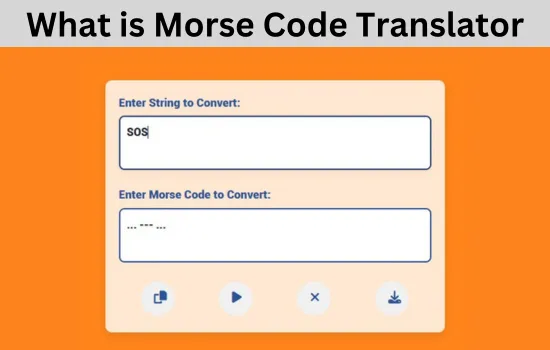Morse Code Translator and Converter
Ready.
Light Blinker Area (Toggle 💡 to enable)
Many users struggle with the timing of dots, dashes, and spaces, which can lead to incorrect translations or miscommunication during the use of Morse Code.
Use a Morse code translator with an audio playback feature. Hearing the correct timing helps users associate sounds with their respective symbols, improving accuracy. Practicing regularly with the audio feature can also reinforce timing patterns.
What is Morse Code Translator?
A Morse Code Translator allows users to encode text into Morse code and decode Morse code back into standard text effortlessly. It simplifies the process of learning and using Morse code by providing an easy-to-use interface for encoding and decoding messages.
With this translator, you can enter letter, words or numbers and it will convert this text into Morse Code.
This tool also provide the audio play button that you can listen your Morse Code beep. This tools are widely used for educational purposes, hobby projects, and even emergency communication training.
Whether you’re a beginner or an enthusiast, a Morse Code Translator is an excellent resource for mastering the timeless language of dots and dashes.

What is Morse Code?
Morse code is a revolutionary communication system that has stood the test of time. Created in the early 19th century, this system of encoding text with dots and dashes has shaped the history of communication and continues to serve practical purposes today.This system translates text into coded sequences, enabling messages to be transmitted through sound, light, or electrical pulses.
Today, Morse code holds historical significance and is still used in areas like aviation, maritime navigation, and emergency signaling.Whether you’re learning it for fun or using it for serious applications, understanding Morse code can open a whole new world of possibilities.

Morse Code Machine
A Morse Code Machine is a tool that encodes text into Morse code and decodes signals back into text. Originally used in telegraph systems, these machines played a crucial role in early communication by transmitting messages as sequences of dots and dashes.
Modern versions of Morse Code Machines are digital, offering audio, visual, or text-based translations. These tools are widely used by enthusiasts and learners to practice Morse code and experience its historical significance in a modern way.

How Morse Code Works
Dots, Dashes, and the Basics of Morse Code
Morse code operates on a simple principle: short signals (dots) and long signals (dashes) combine to represent Letters in Morse Code, numbers, and punctuation. Specific pauses separate these signals, simplifying the decoding and encoding of messages. For example, “.-” (dot-dash) represents the letter “A”, while “.—-” (dot followed by four dashes) represents the number “1”.

Decode Morse Code: A Beginner’s Guide
To decode Morse code, you need to understand the fundamental pattern.A unique pattern of dots and dashes corresponds to each letter and number. For example:
Morse Code Alphabet
Numbers in Morse Code
1: .—-
A: .-
B: -…

The Role of Sound in Morse Code
Morse code isn’t just visual; it also has a distinct auditory component. The dots and dashes are translated into beeps or tones of varying lengths. A short beep represents a dot, while a longer beep signifies a dash. This audio element makes it easier to learn and recognize Morse code, adding an extra layer to the learning experience.

Morse Code Audio Translator and Decoder
A Morse Code Audio Translator is a tool that not only converts text into Morse code but also provides an audible representation of the encoded message.
This feature is invaluable for learning the rhythm and timing of Morse code, as it enables users to associate the distinct sounds of dots (short beeps) and dashes (long beeps) with their corresponding symbols.
The tool plays the generated Morse code in audio format, allowing users to practice listening and decoding skills.
It is especially beneficial for those aiming to master Morse code for practical applications, such as amateur radio, emergency, communication, or historical reenactments. By hearing the actual sound patterns, learners can better understand the pacing and distinguish between letters and words in real-time scenarios.

Features of Morse Code Generator
Effortless Copy to Clipboard
Our Morse Code Translator tool comes with a dedicated “Copy” button. With a single click, you can instantly copy the generated Morse code to your clipboard for easy sharing or saving.
Listen to Morse Code Audio
Experience Morse code like never before! The tool features a “Play” button that converts the generated Morse code into audio. Simply click and listen to the encoded message.
Clear and Start Fresh
Easily reset your work with the “Clear” button. Clicking it clears the current code, allowing you to quickly input new words or phrases for translation.
Download Morse Code Audio
Save your Morse code audio effortlessly! By clicking the “Download” button, you can download the audio as an .mp3 file, making it easy to use the audio offline or share it as needed.